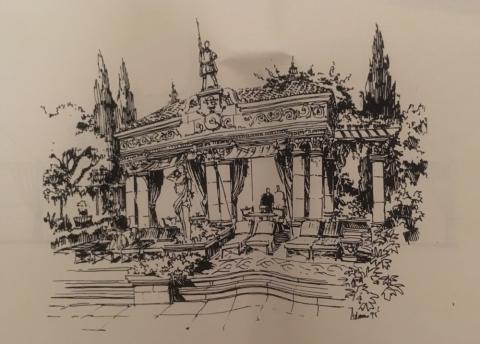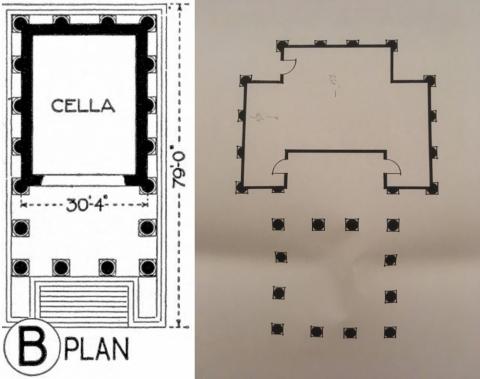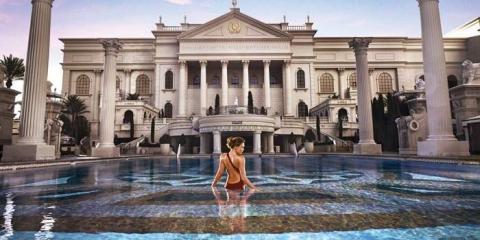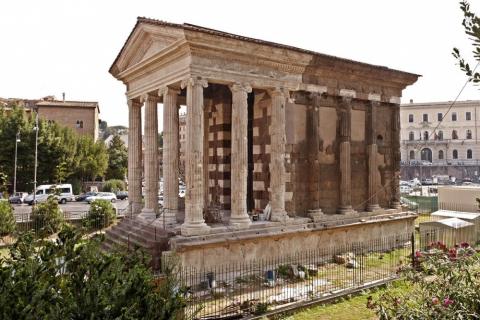
Roman interpretation of classical Greek architecture, or Las Vegas’ interpretation of a Roman interpretation of classical Greek architecture?
Image Credit:Caesars Palace cabana artist’s rendering, John Levy Lighting Productions, Inc. Records, 1992-2017. MS-00832. Special Collections and Archives, University Libraries, University of Nevada, Las Vegas.
In 2016 John Levy, founder of John Levy Lighting Productions, Inc. donated to UNLV Libraries Special Collections & Archives his company’s records, which feature architectural lighting design drawings from concept to completion, demonstrating the expressiveness and technological possibilities of light in Las Vegas, Nevada. His earliest project in Las Vegas was Caesars Palace, the famous Forum Shops sky scape ceiling which through innovative lighting design mimics the changing light of the Roman sky.

Lighting design taking inspiration from nature.
Image Credit: Conceptual sky rendering, John Levy Lighting Productions, Inc. Records, 1992-2017. MS-00832. Special Collections and Archives, University Libraries, University of Nevada, Las Vegas.
The Classical Style of Roman architecture, the model for Caesars Palace, and its Greek forerunner which it imitated, are some of the oldest examples of built form in human history. Through the study and preservation of classical architectural forms, we can learn of the cultures and values of the past, and better understand today’s built environment, and the societies that inhabit it. Self-reflection is still helpful, however, to assess the current state of Las Vegas archtiecture as it continues to evolve and create fantastical new designs.
Below are two temple floor plan diagrams. One is of the Temple of Portunus, also known as the Temple of Fortuna Virilis, located in Rome, Italy. The other is of the Caesars Palace poolside snack bar in Las Vegas.

Left , the Roman temple dedicated to Portunus, the god of keys, doors, and livestock. Right, the Roman temple dedicated to…burgers and a drink?
Image Credit:
Left: Fletcher, Banister. A History of Architecture on the Comparative Method. Sixth edition, rewritten and enlarged. New York: Charles Scribner’s Sons, 1921.
Right: Caesars Palace Las Vegas poolside snack bar, John Levy Lighting Productions, Inc. Records, 1992-2017. MS-00832. Special Collections and Archives, University Libraries, University of Nevada, Las Vegas. Las Vegas, Nevada.
Is the Caesar’s Palace snackbar a harmless homage to classical architecture, or an affront to an ancient culture and the gods they worshiped? De Architectura, also known as On Architecture or The Ten Books on Architecture, was written by Vitruvius Pollio (c. 90 – c. 20 B. E.) and dedicated to Augustus, the first Emperor of Rome. In it, Vitruvius described the manner to which architecture should be approached through an analysis of Greek and Roman art, natural sciences, construction technologies, social well-being, and architectural theory. According to Book III, Chapter II of De Architectura, the human body is perfectly proportioned and symmetrical as characteristics bestowed by nature. Because of this, temples to the Roman gods should also be perfectly proportioned and symmetrical to achieve natural harmony.

The Vitruvian Man
Caption: “The Vitruvian Man,” Leonardo da Vinci (c .1487)
Image Credit: Leonardo da Vinci, https://www.leonardodavinci.net/the-vitruvian-man.jsp
Looking just at the snack bar, how does Las Vegas compare in its recreation of a Roman temple floor plan? Immediately, the side door behind the snack bar’s cella (inner chamber) breaks symmetry.

Snack bar plan One door short, or one door too many?
Image Credit: Caesars Palace Las Vegas poolside snack bar, John Levy Lighting Productions, Inc. Records, 1992-2017. MS-00832. Special Collections and Archives, University Libraries, University of Nevada, Las Vegas. Las Vegas, Nevada.
With their forms, both the Temple of Portunus and the snack bar are “pseudoperipteral” as described in Book IV, Chapter VIII of De Architectura, where there is no space between the cella and the surrounding walls, resulting in the columns being embedded into the cella walls themselves. This is in contrast to a “peripteral,” where there are columns on all four sides of the temple detached from the cella walls, creating a walking path around the cella.
Approaching both structures, both have front portacos surrounded by free-standing columns axially leading up to the cella, but typically the Roman temple should have a spacious, unobstructed path straight inside to allow people to enter with their arms around each other, rather than in single file. Roman temples should also have enough space to allow for walks around the temple, as well as having statues not hidden in shadows due to a lack of space. The snack bar seems to have adequate space, but it also has doors on both sides of the front entrance, disallowing direct access. Multiple entrances are acceptable in Roman temple design, and this may have been for dividing foot traffic, delineating between indoor and outdoor spaces, or separation between back-of-house areas and areas of public access.

Rendering of the Caesars Palace pool
Image Credit: Caesars Entertainment, http://www.caesarstravelagents.com/AgentResources/ImageGallery/LasVegasImageGallery/CaesarsPalace

Photograph of the Temple of Portunus, 2011 Image Credit: World Monuments Fund, https://www.wmf.org/project/temple-portunus
Seemingly following the Corinthian column design, the capitals (tops) of the snack bar’s columns are elaborately designed with acanthus ornaments, a type of plant used for decoration. It’s difficult to discern the proportions of the columns without measurements, but if they were correct, their heights should be equal to the thickness of the bases’ heights. The capitals are correctly divided into three segments denoted by two levels of leaves, and the top of the columns are flat below the architrave, the lower horizontal element, and the frieze, the wider horizontal element above the architrave. Above are decorative sculptures of Roman women and vases placed on flat pedestals, known as acroteria. Vitruvius notes in Book IV, Chapter I that the Corinthian column did not have particular schemes for its other elements, and would either follow the other two orders of Greek architecture, the Doric or Ionic, or any variety of unorganized styles of various names (which is extremely fortunate for a snack bar).

Snack bar front façade elevation
Image Credit: Caesars Palace Las Vegas poolside snack bar, John Levy Lighting Productions, Inc. Records, 1992-2017. MS-00832. Special Collections and Archives, University Libraries, University of Nevada, Las Vegas. Las Vegas, Nevada.

Drawing of an Ionic column
Image Credit: Pollio, Vitruvius, and M. H. Morgan. The Ten Books on Architecture. New Delhi: Kaveri Books, 2016.
So, architecturally, how does the Caesars Palace snack bar fare? Although not all the designs of the Roman temple are followed, most of the characteristics of the Corinthian order are present. The Corinthian order is flexible in its approach to proportions and stylistics, allowing for malleability in adapting the order to Las Vegas’ needs. All that being said, the Roman temples were primarily created for permanence and dedication. The Caesars Palace drawings here are not dedicated to any particular entity or person, and the temple seems to have been replaced by Neptunes Bar, at least for the moment. For Las Vegas, contemporary relevance in adapting to constantly changing technologies and styles may take precedence. While the Temple of Portunus, constructed sometime between the late second to mid-first century B. C., is still preserved to this very day, the Caesars Palace snack bar has undergone multiple redesigns since 1996, the date of the snack bar’s drawings. As a result, the Levy drawings may be some of the last records of this particular design iteration of Caesars Palace which documents the development of immitation architectural styles of Las Vegas.
To view some of the John Levy Papers designs in person, visit the exhibit "Transfigured night: Lighting the Las Vegas Skyline" curated by Peter Michel, in the Special Collections & Archives exterior reading room on the 3rd floor of Lied Library.


